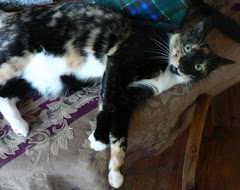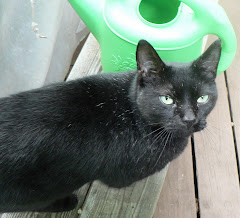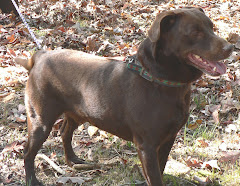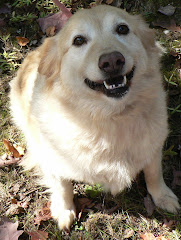Thursday, February 28, 2013
Rip it or not...that is the question, or is it??
OK, while the photo is smaller than I would normally make it, that's because I am still working on the tutorial.
I like the two darker versions, but the top was supposed to evoke Mardi Gra/Carnivale. Couldn't find the lighter color twin beads I knew I had. Looked in the box they were supposed to live in. Nope. Did I send them to someone....nope.
Of COURSE, after I get this far, I find them. I didn't like how dark the center twin iris purple green were, so need to decide- rip it, or just make another.
I won't wear this, so will probably just rip it out and start again...
Oh well, those who know me, know that's how it is.
Stay tuned for the better, more colorful version.
And those light purple and aqua twins?????
They were hiding out in the Boot's tray of beady things!
Durned Boot- always gotta have the best for itself :-)
Happy Beading!
Aryd'ell
Friday, February 22, 2013
Lady's Boot- the Home Stretch!
Click on any of the photos to see them original size...
Back to beading- that Feb 28 deadline is coming up!
making the base for a standing art doll form
This is only one way to do it, and this tut is for what is commonly called a 'stump'doll, because it resembles (faintly) a cut-off stump, at the doll's base.
It is a great way to form an angel, tree doll, teapot, or other doll without legs, that you want to stand on its own once it has been stuffed and beaded.
See how nicely the teapot dolls stand up in the photo above? You, too, can learn how to make your stump or flat base dolls stand, and I will show you some tricks to do it!
Photo was shared with me, so I cannot give credit for whose dolls those are- but aren't they wonderful?!? If someone knows, please inform me via comment, so I can give credit!
Now, let's get started!
First, sew your form, turn it right-side out, then iron a small fold up at the base. I usually make mine somewhere between 1/4 and 3/8", having left that much when I cut out the form after sewing. It must be ironed up to the seams on either side.
See, here is the pinked, folded-in edge.
You can use different objects to sort of eyeball how big to make the oval or circle. Jar lids come in handy for this. Trace around them on paper, once you find one to fit inside the bottom of your form, then draw it out into an oval on either side of the circle you just drew. Cut it out, then starting at one seam, match the paper to the cloth base of the form and see how close you got. Trim the paper if necessary. Then use your paper to draw the lines on the wrong side and sew. Put right sides of fabric together, sew one half the long way, then turn and iron-making a fold on the unsewn half, like was done on the body in the previous step.
Here, double check your base after it is sewn. You can see the amount on either side where it didn't meet. That will be taken up by the circle, and seems to be the formula for making ovals fit, at least for me.
Now we need something inside the oval cloth base, so that when you stuff it, it remains fairly, if not perfectly, flat. I tried cardboard from cereal boxes, but even several layers of that will bend if you add enough stuffing. See the bottom of the Lady's Boot in previous posts, for that pooched look. That just won't get it, if you want your form to stand. It seems the harder plastic from the containers meat or deli chicken come in are just about perfect. If you are going to stuff REALLY hard, you can use several pieces. Just don't use styrofoam, as it will crack and break. If you cannot break the plastic with your hands, but can cut it with child's Fiskar scissors, that is exactly the right one. Be sure to wash and dry it completely before using.
I laid the cloth oval underneath the plastic, then cut the plastic out to match.
I then took the plastic piece and put it inside the form base, to see if it matched in size, starting from one seam and measuring by moving the plastic along the ironed fold to the other corner. My plastic's corners matched both seams, so it is a go!
Now we have to be sure the plastic fits inside the oval fabric. The seams inside take up a bit of the room, so I had to trim the plastic to be sure it would fit inside. You can see the bits I trimmed off on the right.
Put it fully inside the oval base, and push your open edges together, to make sure it really fits nicely inside. If you cut the plastic a little bit short, either cut a new piece, or plan to add some beautiful round or oval beads, sewn in a line at the base of your form, once you begin to bead. This also helps if your form is top-heavy, like a tree!
This is what I use to sew the edges together;curved #10 John James beading needle, size B Nymo, beeswax, and scissors. I finally figured out WHY I love those needles for everything; short needles, like sharps, are too small for my fingers, long needles bend however they want, not now YOU want, so the curved give me room to hold on and the curve goes right where I need it, plus it shortens the length between the top and end, so I get the point just where it needs to go. You can use whatever needle you prefer. I use Nymo here, because it is easy to match colors, and it doesn't twist and fray like sewing thread does. Beeswax keeps me from cursing the Nymo LOL!
Make a knot at the end of your thread, put the thread onto the needle, then take your first stitch inside the area that has already been machine-sewn, This will help keep your piece from coming apart from tension, and your knot in place better than just through open fabric seams.
Make two stitches in the same place, then start your blanket stitch. Blanket stitch takes the needle a short, SHORT way to the next place you wish to make your stitch, then make another stitch in the exact same place before moving in. It creates a diagonal line where you first move the needle, then a straight line around the edge with the second stitch. Make tiny stitches.....pretend you are sewing for the Queen!
Keep your stitches to the outside of the folds, and try to not catch any lower folds, like seams, with your needle....my curved needle is especially good for this!
Starting a the lower portion, see how the red line first makes a diagonal, then a straight line across the folded edges?
Continue the blanket stitch, bringing the edges together with your fingers.
See that pretty blanket stitch??
Oh, dear! One side is longer than the other (the back side). No worries. You have two choices to fix it.
One is to pull the edges away from the plastic and trim it a tiny bit. Do this if you cannot get the edges together by tugging....which is the second method!
Tugging on the shorter side, the edges now meet and I can continue the blanket stitch.
Once your bottom piece is sewn all the way around, you can continue with the same thread if you have enough. If you do not have much thread left, attach a new piece to the bottom on the inside, or where the stuffing will touch, near the outside of the oval or circle, but about 1/4 inch inside. You will begin attaching this to the top form near the seam, but not exactly at the seam. You can see where I took a stitch to connect the two just to the left of the seam on the top of the form in the photo above.
More blanket stitch- and this is where it is crucial that your stitches be tiny and close together. 1/16" apart and tall is not too small. If your stitches are too large, either stuffing may come out when you stuff your form, or it may come apart altogether from the pressure of the stuffing. Large stitches can also cause your fabric to tear, your teeth to gnash and your mouth to wail! Tiny stitches, and the Queen will be proud of her seamstress!
Match the edges as you stitch, and sew only through the cloth, not the plastic.
Another 'oh dear' moment, but WAIT! No worries- this is fabric, remember? When you get 1/2 of the way around sewn, stop and put the other side's edge to your base. If the top form seems too large, like the photo above shows, or too small, just use your fingers to roll that seam in or out a bit to match. That's why I leave a larger than normal seam- would rather have too much, than too little, to fix this with. It is also why I like to use pinking shears, so that all this rolling and moving doesn't cause my edges to fray!
See, it matches up nicely, now that I rolled a bit of the top form's edge inside of that form.
Continue your blanket stitch all around, going past where you started, and easing in any little bit that might not exactly match up, as you go. A couple of times around in the same place, and cut your thread near the form.
You can barely see the stitches on the base.
But she will stand nicely, once stuffed!!
And here is her friend, Tree Goddess, who will undoubtedly need some larger beads sewn around the base area, to add width, as her top is so much wider than the base.
But still, they stand, and so will yourss....so give it a go!
Happy Beading AND sewing!
Aryd'ell
Sunday, February 10, 2013
Lady's boot- one step forward, one back
Had to take the base off- absolutely did not like how it turned out, and it was getting more and more rounded by the day. Add in the heel mushing about, and being in the wrong position to support the boot standing, well, time to get out the scissors.
Here is one shot of it full, before removing. You can see the heel coming to one side.
Here is the fixed base, using long, 1 inch bugles, with size 11 seed beads filling in the center. The heel bit was removed, and folded strips of grocery bag stuffed into it, then replaced in a better position. The entire boot was sewn a bit off-center, but this is still a major improvement, and no sag in the heel!
And here is the fun beading part; adding 8mm chatons, each surrounded differently, and beaded off-boot before being stitched on. Each paisley will also be beaded differently. It's fun using the same beads and colors to create different looks, that then all work together.
Back to beading!! Happy Sunday, everyone!
Here is one shot of it full, before removing. You can see the heel coming to one side.
Here is the fixed base, using long, 1 inch bugles, with size 11 seed beads filling in the center. The heel bit was removed, and folded strips of grocery bag stuffed into it, then replaced in a better position. The entire boot was sewn a bit off-center, but this is still a major improvement, and no sag in the heel!
And here is the fun beading part; adding 8mm chatons, each surrounded differently, and beaded off-boot before being stitched on. Each paisley will also be beaded differently. It's fun using the same beads and colors to create different looks, that then all work together.
Back to beading!! Happy Sunday, everyone!
Friday, February 8, 2013
Valentines earring swap at Beaddreamz yahoo group
From Alexia, in VA! The earrings are ivory cabs, agate cabs, ivory rounds, tourmaline, aquamarine, and agate small rounds, sterling silver, lots of little crystals- long and dangly. These are quickly becoming my favorites to wear every day..they seem to go with all my regular outfits!
She also sent me a couple of wonderful bone faces, and a raku tribal face, with two raku leaves, that I am contemplating making into a tribal spirit doll.
Thank you so much, Alexia dear!
She also sent me a couple of wonderful bone faces, and a raku tribal face, with two raku leaves, that I am contemplating making into a tribal spirit doll.
Thank you so much, Alexia dear!
Subscribe to:
Comments (Atom)




























































.png)







